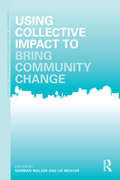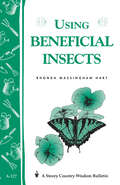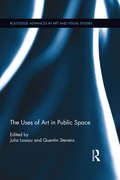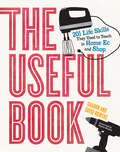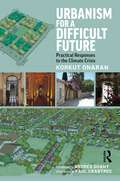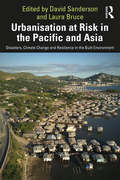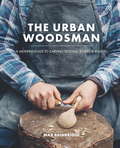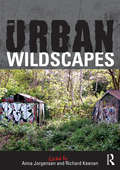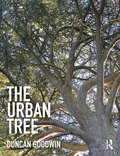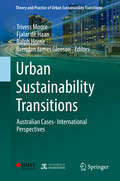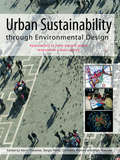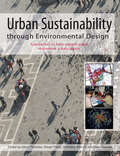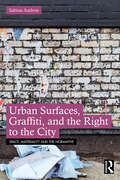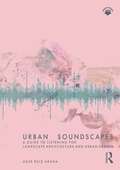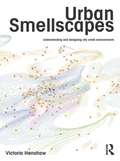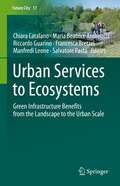- Table View
- List View
Using Collective Impact to Bring Community Change (Community Development Research and Practice Series)
by Norman Walzer Liz WeaverCollective Impact as a tool to bring about community change has seen remarkable growth in usage since 2011. Collective Impact has been used successfully with a variety of local issues and has raised the consciousness of how community groups interact as well as the approaches that can lead to long-term innovations. This edited volume sets forth conceptual foundations for using Collective Impact as well as sharing basic approaches that have succeeded in projects under diverse circumstances. It will be useful for both academics and practitioners as Collective Impact continues to undergo substantial changes in focus and direction. Building on Kania and Kramer’s influential work, it provides readers with detailed insights not only into how the Collective Impact system works but also innovative applications to issues facing community developers. The diverse topics shared by the contributing authors make this volume especially important for practitioners designing programs to bring about long-term changes in their communities. Including discussion about how Collective Impact has succeeded in different governmental settings, this book demonstrates how Collective Impact has been modified to accommodate the associated cultural differences with 10 chapters written by experienced on-the-ground community development experts.
Using Collective Impact to Bring Community Change (Community Development Research and Practice Series)
by Norman Walzer Liz WeaverCollective Impact as a tool to bring about community change has seen remarkable growth in usage since 2011. Collective Impact has been used successfully with a variety of local issues and has raised the consciousness of how community groups interact as well as the approaches that can lead to long-term innovations. This edited volume sets forth conceptual foundations for using Collective Impact as well as sharing basic approaches that have succeeded in projects under diverse circumstances. It will be useful for both academics and practitioners as Collective Impact continues to undergo substantial changes in focus and direction. Building on Kania and Kramer’s influential work, it provides readers with detailed insights not only into how the Collective Impact system works but also innovative applications to issues facing community developers. The diverse topics shared by the contributing authors make this volume especially important for practitioners designing programs to bring about long-term changes in their communities. Including discussion about how Collective Impact has succeeded in different governmental settings, this book demonstrates how Collective Impact has been modified to accommodate the associated cultural differences with 10 chapters written by experienced on-the-ground community development experts.
Using Beneficial Insects: Storey's Country Wisdom Bulletin A-127 (Storey Country Wisdom Bulletin)
by Rhonda Massingham HartSince 1973, Storey's Country Wisdom Bulletins have offered practical, hands-on instructions designed to help readers master dozens of country living skills quickly and easily. There are now more than 170 titles in this series, and their remarkable popularity reflects the common desire of country and city dwellers alike to cultivate personal independence in everyday life.
The Uses of Art in Public Space (Routledge Advances in Art and Visual Studies)
by Julia Lossau Quentin StevensThis book links two fields of interest which are too seldom considered together: the production and critique of art in public space and social behaviour in the public realm. Whilst most writing about public art has focused on the aesthetic, cultural and political intentions and processes that shape its production, this edited collection examines a variety of public artworks from the perspective of their actual everyday use. Contributors are interested in the rich diversity of peoples’ engagements with public artworks across various spatial and temporal scales, encounters which do not limit themselves to the representational aspects of the art, and which are not necessarily as the artist, curator or sponsor intended. Case studies consider a broad range of public art, including commissioned and unofficial artworks, memorials, street art, street furniture, performance art, sound art and media installations.
The Uses of Art in Public Space (Routledge Advances in Art and Visual Studies)
by Julia Lossau Quentin StevensThis book links two fields of interest which are too seldom considered together: the production and critique of art in public space and social behaviour in the public realm. Whilst most writing about public art has focused on the aesthetic, cultural and political intentions and processes that shape its production, this edited collection examines a variety of public artworks from the perspective of their actual everyday use. Contributors are interested in the rich diversity of peoples’ engagements with public artworks across various spatial and temporal scales, encounters which do not limit themselves to the representational aspects of the art, and which are not necessarily as the artist, curator or sponsor intended. Case studies consider a broad range of public art, including commissioned and unofficial artworks, memorials, street art, street furniture, performance art, sound art and media installations.
The Useful Book: 201 Life Skills They Used to Teach in Home Ec and Shop
by David Bowers Sharon BowersA modern and energetically designed encyclopedia of DIY with everything you need to know to roll up your sleeves and cook it, build it, sew it, clean it, or repair it yourself. In other words, everything you would have learned from your shop and home ec teachers, if you'd had them.The Useful Book features 138 practical projects and how-tos, with step-by-step instructions and illustrations, relevant charts, sidebars, lists, and handy toolboxes. There&’s a kitchen crash course, including the must-haves for a well-stocked pantry; how to boil an egg (and peel it frustration-free); how to grill, steam, sauté, and roast vegetables. There&’s Sewing 101, plus how to fold a fitted sheet, tie a tie, mop a floor, make a bed, and set the table for a formal dinner. Next up: a 21st-century shop class. The tools that everyone should have, and dozens of cool projects that teach fundamental techniques. Practice measuring, cutting, and nailing by building a birdhouse. Make a bookshelf or a riveted metal picture frame. Plus: do-it-yourself plumbing; car repair basics; and home maintenance, from priming and painting to refinishing wood floors.
Urbanism for a Difficult Future: Practical Responses to the Climate Crisis
by Korkut OnaranUrbanism for a Difficult Future: Practical Responses to the Climate Crisis is a much-needed guide to launching the next generation of land use planning and urbanism that will enable us to adapt to and survive the consequences of climate change. The book offers strong, straightforward measures for creating a landscape of resilience via pockets of self-sufficiencies. It demonstrates how to secure systems that sustain life (energy, water, food, waste, and production of essential goods) as well as political and social protocols enabling agile decision-making in managing these systems effectively at local levels. It also provides the design principles for creating a built environment that will enable the kind of localization we need for adaptation. The book explores how it is possible to create a life that does not depend on large-scale regional sustenance systems which are likely to be disrupted or fail. This book uncovers how to enable people to be creative, productive, and supportive at local levels, so that we can achieve strong and diverse local economies that can sustain life. It will appeal to students, planners, and policy makers working in environmental studies, environmental engineering, urban and regional planning, architecture, landscape architecture, and urbanism.
Urbanism for a Difficult Future: Practical Responses to the Climate Crisis
by Korkut OnaranUrbanism for a Difficult Future: Practical Responses to the Climate Crisis is a much-needed guide to launching the next generation of land use planning and urbanism that will enable us to adapt to and survive the consequences of climate change. The book offers strong, straightforward measures for creating a landscape of resilience via pockets of self-sufficiencies. It demonstrates how to secure systems that sustain life (energy, water, food, waste, and production of essential goods) as well as political and social protocols enabling agile decision-making in managing these systems effectively at local levels. It also provides the design principles for creating a built environment that will enable the kind of localization we need for adaptation. The book explores how it is possible to create a life that does not depend on large-scale regional sustenance systems which are likely to be disrupted or fail. This book uncovers how to enable people to be creative, productive, and supportive at local levels, so that we can achieve strong and diverse local economies that can sustain life. It will appeal to students, planners, and policy makers working in environmental studies, environmental engineering, urban and regional planning, architecture, landscape architecture, and urbanism.
Urbanisation at Risk in the Pacific and Asia: Disasters, Climate Change and Resilience in the Built Environment
by David Sanderson Laura BruceThis book presents practical approaches for tackling the threats from climate change and disasters to urban growth in Pacific island countries and Asian nations. With chapters written by leading scholars and practitioners, Urbanisation at Risk presents research and case studies from island countries across the Pacific, Cambodia, Nepal and the Philippines. The book explores and presents the theory, policy and practice of how governments, civil society, aid organisations and people themselves prepare for, withstand and recover better from urban disasters including windstorms, floods, earthquakes and fires, and the effects of climate change. This book is written for urban policy makers, researchers, humanitarian aid and development workers, and anyone interested in urbanisation, participatory approaches, disasters, resilience and climate change adaptation.
Urbanisation at Risk in the Pacific and Asia: Disasters, Climate Change and Resilience in the Built Environment
by David Sanderson Laura BruceThis book presents practical approaches for tackling the threats from climate change and disasters to urban growth in Pacific island countries and Asian nations. With chapters written by leading scholars and practitioners, Urbanisation at Risk presents research and case studies from island countries across the Pacific, Cambodia, Nepal and the Philippines. The book explores and presents the theory, policy and practice of how governments, civil society, aid organisations and people themselves prepare for, withstand and recover better from urban disasters including windstorms, floods, earthquakes and fires, and the effects of climate change. This book is written for urban policy makers, researchers, humanitarian aid and development workers, and anyone interested in urbanisation, participatory approaches, disasters, resilience and climate change adaptation.
The Urban Woodsman
by Max BainbridgeHand carving is easy, satisfying and therapeutic when guided by Max Bainbridge. Create your own unique pieces and carve with confidence thanks to detailed information on tools, cutting techniques and clear step-by-step photography accompanying each project. Start with basic spoons, cooking spoons and spatulas, before moving onto butter knives, chopping boards and small bowls, with only a few simple tools required. Max also advises on the perfect finish for your projects - how to sand, ebonise, scorch and texture surfaces as well as waxing and oiling your new creations. Whether you are a novice or an experienced carver, this book will inspire you to make something that you will be proud of.
Urban Wildscapes
by Anna Jorgensen Richard KeenanUrban Wildscapes is one of the first edited collections of writings about urban ‘wilderness’ landscapes. Evolved, rather than designed or planned, these derelict, abandoned and marginal spaces are frequently overgrown with vegetation and host to a wide range of human activities. They include former industrial sites, landfill, allotments, cemeteries, woods, infrastructural corridors, vacant lots and a whole array of urban wastelands at a variety of different scales. Frequently maligned in the media, these landscapes have recently been re-evaluated and this collection assembles these fresh perspectives in one volume. Combining theory with illustrated examples and case studies, the book demonstrates that urban wildscapes have far greater significance, meaning and utility than is commonly thought, and that an appreciation of their particular qualities can inform a far more sustainable approach to the planning, design and management of the wider urban landscape. The wildscapes under investigation in this book are found in diverse locations throughout the UK, Europe, China and the US. They vary in scale from small sites to entire cities or regions, and from discrete locations to the imaginary wildscapes of children’s literature. Many different themes are addressed including the natural history of wildscapes, their significance as a location for all kinds of playful activity, the wildscape as ‘commons’ and the implications for landscape architectural practice, ranging from planting interventions in wildscapes to the design of the urban public realm on wildscape principles.
The Urban Tree
by Duncan GoodwinThere is a growing evidence base that documents the social, environmental and economic benefits that urban trees can deliver. Trees are, however, under threat today as never before due to competition for space imposed by development, other hard infrastructures, increased pressure on the availability of financial provision from local authorities and a highly cautious approach to risk management in a modern litigious society. It is, therefore, incumbent upon all of us in construction and urban design disciplines to pursue a set of goals that not only preserve existing trees where we can, but also ensure that new plantings are appropriately specified and detailed to enable their successful establishment and growth to productive maturity. Aimed at developers, urban planners, urban designers, landscape architects and arboriculturists, this book takes a candid look at the benefits that trees provide alongside the threats that are eliminating them from our towns and cities. It takes a simple, applied approach that explores a combination of science and practical experience to help ensure a pragmatic and reasoned approach to decision-making in terms of tree selection, specification, placement and establishment. In this way, trees can successfully be incorporated within our urban landscapes, so that we can continue to reap the benefits they provide.
The Urban Tree
by Duncan GoodwinThere is a growing evidence base that documents the social, environmental and economic benefits that urban trees can deliver. Trees are, however, under threat today as never before due to competition for space imposed by development, other hard infrastructures, increased pressure on the availability of financial provision from local authorities and a highly cautious approach to risk management in a modern litigious society. It is, therefore, incumbent upon all of us in construction and urban design disciplines to pursue a set of goals that not only preserve existing trees where we can, but also ensure that new plantings are appropriately specified and detailed to enable their successful establishment and growth to productive maturity. Aimed at developers, urban planners, urban designers, landscape architects and arboriculturists, this book takes a candid look at the benefits that trees provide alongside the threats that are eliminating them from our towns and cities. It takes a simple, applied approach that explores a combination of science and practical experience to help ensure a pragmatic and reasoned approach to decision-making in terms of tree selection, specification, placement and establishment. In this way, trees can successfully be incorporated within our urban landscapes, so that we can continue to reap the benefits they provide.
Urban Sustainability Transitions: Australian Cases- International Perspectives (Theory and Practice of Urban Sustainability Transitions)
by Trivess Moore Fjalar De Haan Ralph Horne Brendan James GleesonThis book contributes to current debates regarding purposive transitions to sustainable cities, providing an accessible but critical exploration of sustainability transitions in urban settings. We have now entered the urban century, which is not without its own challenges, as discussed in the preceding book of this series. Urbanization is accompanied by a myriad of complex and overlapping environmental, social and governance challenges – which increasingly call into question conventional, market-based responses and simple top-down government interventions. Faced with these challenges, urban practitioners and scholars alike are interested in promoting purposive transitions to sustainable cities. The chapters in this volume contribute to the growing body of literature on city-scale transformative change, which seeks to address a lack of consideration for spatial and urban governance dimensions in sustainability transitions studies, and expand on the basis established in the preceding book. Drawing on a range of perspectives and written by leading Australian and international urban researchers, the chapters explore contemporary cases from Australia and locate them within the international context. Australia is on the one hand representative of many OECD countries, while on the other possessing a number of unique attributes that may serve to highlight issues and potentials internationally. Australia is a highly urbanized country and because of the federal political structure and the large distances, the five largest state-capital cities have a relatively high degree of autonomy in governance – even dominating the rest of their respective states and rural hinterlands to a certain extent. This context suggests that Australian cases can provide interesting “test-tube” perspectives on processes relevant to urban sustainability transitions worldwide. This volume presents an extensive overview of theories, concepts, approaches and practical examples informed by sustainability transitions thinking, offering a unique resource for all urban practitioners and scholars who want to understand and transition to sustainable urban futures.
Urban Sustainability Through Environmental Design: Approaches to Time-People-Place Responsive Urban Spaces
by Kevin Thwaites Sergio Porta Ombretta Romice Mark GreavesWhat can architects, landscape architects and urban designers do to make urban open spaces, streets and squares, more responsive, lively and safe? Urban Sustainability through Environmental Design answers this question by providing the analytical tools and practical methodologies that can be employed for sustainable solutions to the design and management of urban environments. The book calls into question the capability of ‘quick-fix’ development solutions to provide the establishment of fixed communities and suggests a more time-conscious and evolutionary approach. This is the first significant book to draw together a pan-European view on sustainable urban design with a specific focus on social sustainability. It presents an innovative approach that focuses on the tools of urban analysis rather than the interventions themselves. With its practical approach and wide-ranging discussion, this book will appeal to all those involved in producing communities and spaces for sustainable living, from students to academics through to decision makers and professional leaders.
Urban Sustainability Through Environmental Design: Approaches to Time-People-Place Responsive Urban Spaces
by Kevin Thwaites Sergio Porta Ombretta Romice Mark GreavesWhat can architects, landscape architects and urban designers do to make urban open spaces, streets and squares, more responsive, lively and safe? Urban Sustainability through Environmental Design answers this question by providing the analytical tools and practical methodologies that can be employed for sustainable solutions to the design and management of urban environments. The book calls into question the capability of ‘quick-fix’ development solutions to provide the establishment of fixed communities and suggests a more time-conscious and evolutionary approach. This is the first significant book to draw together a pan-European view on sustainable urban design with a specific focus on social sustainability. It presents an innovative approach that focuses on the tools of urban analysis rather than the interventions themselves. With its practical approach and wide-ranging discussion, this book will appeal to all those involved in producing communities and spaces for sustainable living, from students to academics through to decision makers and professional leaders.
Urban Surfaces, Graffiti, and the Right to the City (ISSN)
by Sabina AndronThis landmark book focuses on urban surfaces, on exploring their authorship and management, and on their role in struggles for the right to the city.Graffiti, pristine walls, advertising posters, and municipal signage all compete on city surfaces to establish and imprint their values on our environments. It is the first time that the surfacescapes of our cities are granted the entire attention of a book as material, visual, and legal territories. The book includes a critical history of graffiti and street art as contested surface discourses and argues for surfaces as sites of resistance against private property, neoliberal creativity, and the imposition of urban order. It also proposes a seven-point manual for a semiotics of urban surfaces, laying the ground for a new discipline: surface studies.Page after page and layer after layer, surfaces become porous and political and emerge as key spatial conditions for rethinking and re-practicing urban dwelling and spatial justice. They become what the author terms the surface commons.The book will appeal to a wide readership across the disciplines of urban studies, architectural theory and design, graffiti, street art and public art, criminology, semiotics, visual culture, and urban and legal geography. It will also serve as a tool for city scholars, policy makers, artists, and vandals to disrupt existing imaginaries of order, justice, and visibility in cities.
Urban Surfaces, Graffiti, and the Right to the City (ISSN)
by Sabina AndronThis landmark book focuses on urban surfaces, on exploring their authorship and management, and on their role in struggles for the right to the city.Graffiti, pristine walls, advertising posters, and municipal signage all compete on city surfaces to establish and imprint their values on our environments. It is the first time that the surfacescapes of our cities are granted the entire attention of a book as material, visual, and legal territories. The book includes a critical history of graffiti and street art as contested surface discourses and argues for surfaces as sites of resistance against private property, neoliberal creativity, and the imposition of urban order. It also proposes a seven-point manual for a semiotics of urban surfaces, laying the ground for a new discipline: surface studies.Page after page and layer after layer, surfaces become porous and political and emerge as key spatial conditions for rethinking and re-practicing urban dwelling and spatial justice. They become what the author terms the surface commons.The book will appeal to a wide readership across the disciplines of urban studies, architectural theory and design, graffiti, street art and public art, criminology, semiotics, visual culture, and urban and legal geography. It will also serve as a tool for city scholars, policy makers, artists, and vandals to disrupt existing imaginaries of order, justice, and visibility in cities.
Urban Soundscapes: A Guide to Listening for Landscape Architecture and Urban Design
by Usue Ruiz AranaSound and listening are intrinsically linked to how we experience and engage with places and communities. This guide puts forward a new conceptual framework of embodied affectivity that emphasises listening in urban research and design and advances new ways of knowing and making. The guide invites landscape architects and urban designers to become soundscape architects and offers practical advice on sound and listening applicable to each stage of a design project: from reading the environment to intervening on it.Urban Soundscapes foregrounds listening as an affective mediator between subjects and multispecies environments, and a vehicle to think and conceptualise environmental research and design beyond prevailing visual and human-centred modes. The guide expands landscape architects’ and urban designers’ tools and skills to assess existing soundscapes, predict how those soundscapes will be altered through their designs, consider sound as a creative and active part of the design process and envisage how users might perceive and be affected by those soundscapes as they evolve in time. The volume sits in the interface of research and practice and interweaves theoretical, methodological and creative contributions from acoustic ecology, ecoacoustics, bioacoustics and sound art. Each of the design stages is illustrated through project examples that demonstrate the many advantages of incorporating attentive listening and sound into Landscape Architecture and Urban Design Practice. This book shows how incorporating listening and sounding as part of the design process promotes slow and subtle ways of practice, adds social and ecological value through the reduction of noise pollution and by monitoring the health of habitats, and enables the design of soundscapes that complement the character and design intent of a scheme and elicit joy and wonder.The book will be of interest to practitioners and academics in landscape architecture, and other design and spatial fields such as urban design, architecture, geography and engineering, who play a primary role in the composition of the soundscape.
Urban Soundscapes: A Guide to Listening for Landscape Architecture and Urban Design
by Usue Ruiz AranaSound and listening are intrinsically linked to how we experience and engage with places and communities. This guide puts forward a new conceptual framework of embodied affectivity that emphasises listening in urban research and design and advances new ways of knowing and making. The guide invites landscape architects and urban designers to become soundscape architects and offers practical advice on sound and listening applicable to each stage of a design project: from reading the environment to intervening on it.Urban Soundscapes foregrounds listening as an affective mediator between subjects and multispecies environments, and a vehicle to think and conceptualise environmental research and design beyond prevailing visual and human-centred modes. The guide expands landscape architects’ and urban designers’ tools and skills to assess existing soundscapes, predict how those soundscapes will be altered through their designs, consider sound as a creative and active part of the design process and envisage how users might perceive and be affected by those soundscapes as they evolve in time. The volume sits in the interface of research and practice and interweaves theoretical, methodological and creative contributions from acoustic ecology, ecoacoustics, bioacoustics and sound art. Each of the design stages is illustrated through project examples that demonstrate the many advantages of incorporating attentive listening and sound into Landscape Architecture and Urban Design Practice. This book shows how incorporating listening and sounding as part of the design process promotes slow and subtle ways of practice, adds social and ecological value through the reduction of noise pollution and by monitoring the health of habitats, and enables the design of soundscapes that complement the character and design intent of a scheme and elicit joy and wonder.The book will be of interest to practitioners and academics in landscape architecture, and other design and spatial fields such as urban design, architecture, geography and engineering, who play a primary role in the composition of the soundscape.
Urban Smellscapes: Understanding and Designing City Smell Environments
by Victoria HenshawWe see the city, we hear the city, but above all: we smell the city. Scent has unique qualities: ubiquity, persistence, and an unparalleled connection to memory, yet it has gone overlooked in discussions of sensory design. What scents shape the city? How does scent contribute to placemaking? How do we design smell environments in the city? Urban Smellscapes makes a notable contribution towards the growing body of literature on the senses and design by providing some answers to these questions and contributing towards the wider research agenda regarding how people sensually experience urban environments. It is the first of its kind in examining the role of smell specifically in contemporary experiences and perceptions of English towns and cities, highlighting the perception of urban smellscapes as inter-related with place perception, and describing odour’s contribution towards overall sense of place. With case studies from factories, breweries, urban parks, and experimental smell environments in Manchester and Grasse, Urban Smellscapes identifies processes by which urban smell environments are managed and controlled, and gives designers and city managers tools to actively use smell in their work.
Urban Smellscapes: Understanding and Designing City Smell Environments
by Victoria HenshawWe see the city, we hear the city, but above all: we smell the city. Scent has unique qualities: ubiquity, persistence, and an unparalleled connection to memory, yet it has gone overlooked in discussions of sensory design. What scents shape the city? How does scent contribute to placemaking? How do we design smell environments in the city? Urban Smellscapes makes a notable contribution towards the growing body of literature on the senses and design by providing some answers to these questions and contributing towards the wider research agenda regarding how people sensually experience urban environments. It is the first of its kind in examining the role of smell specifically in contemporary experiences and perceptions of English towns and cities, highlighting the perception of urban smellscapes as inter-related with place perception, and describing odour’s contribution towards overall sense of place. With case studies from factories, breweries, urban parks, and experimental smell environments in Manchester and Grasse, Urban Smellscapes identifies processes by which urban smell environments are managed and controlled, and gives designers and city managers tools to actively use smell in their work.
Urban Services to Ecosystems: Green Infrastructure Benefits from the Landscape to the Urban Scale (Future City #17)
by Chiara Catalano Maria Beatrice Andreucci Riccardo Guarino Francesca Bretzel Manfredi Leone Salvatore PastaThe aim of this book is to bring together multidisciplinary research in the field of green infrastructure design, construction and ecology. The main core of the volume is constituted by contributions dealing with green infrastructure, vegetation science, nature-based solutions and sustainable urban development. The green infrastructure and its ecosystem services, indeed, are gaining space in both political agendas and academic research. However, the attention is focused on the services that nature is giving for free to and for human health and survival. What if we start to see things from another perspective? Our actions shall converge for instance to turn man-made environment like cities from heterotrophic to autotrophic ecosystems. From landscape ecology to urban and building design, like bricks of a wall, from the small scale to the bigger landscape scale via ecological networks and corridors, we should start answering these questions: what are the services that are we offering to Nature? What are we improving? How to implement our actions? This book contains three Open Access chapters, which are licensed under the terms of the Creative Commons Attribution 4.0 International License (CC BY 4.0).
The Urban Section: An analytical tool for cities and streets
by Robert ManthoThe design of streets, and the connections between streets of different character, is the most important task for architects and urbanists working in an urban context. Considered at two distinct spatial scales – that of the individual street – the Street Section – and the complex of city streets – the City Transect – Urban Section identifies a range of generic street types and their success or otherwise in responding to climatic, cultural, traditional, morphological, social and economic well being. Using comparative studies a profile of best practice in street and city design is identified, showing methodologies in both the analysis of, and design for, successful streets and public places – place-making. In uniquely dealing with both the historic and contemporary description and analysis of urban ‘streets’ around the world, the work is of both academic and professional interest to architects, urban planners and designers, highway engineers, landscape and urban design advisers in both the public and private sectors; students, amenity and civic societies, city authorities and government agencies.
